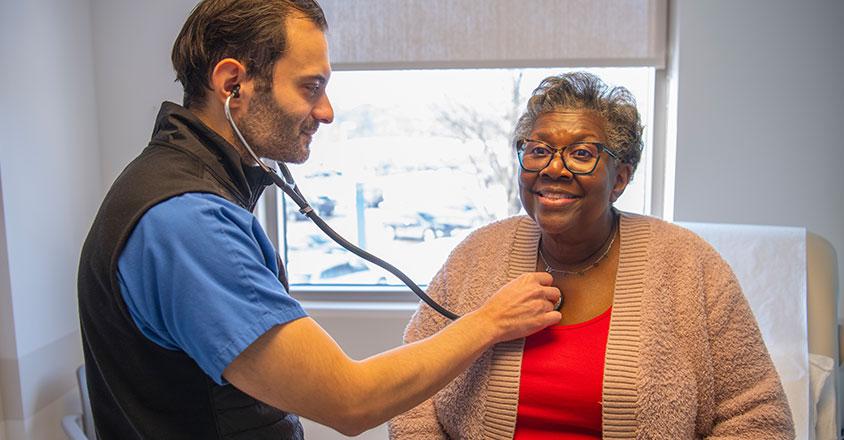

Advanced minimally invasive treatments tackle structural heart disease
Monday, October 26, 2020
It's been said "it always seems impossible until it's done." This statement couldn't be truer for the advanced minimally invasive treatments used today for structural heart disease. As one of the most exciting and fastest growing fields in cardiovascular medicine, technological developments over the last decade have led to previously unthinkable procedures becoming a successful option for a wide range of patients with defects or disorders in their heart's structure.
Not all heart disease is the same
Eating healthy and exercising is important for preventing coronary heart disease, which is caused by plaque buildup in the arteries that can cause chest pain and even heart attack. But, structural heart disease is different.
A heart problem that is structural may be present at birth (congenital) causing conditions such as a hole within the chambers of the heart. Structural heart disease acquired through wear and tear due to aging and time can lead to a tight aortic valve (aortic stenosis), or a leaky heart valve (mitral valve regurgitation) causing some blood to leak backward through the valve.
For patients with severe aortic stenosis, or narrowing of the aortic valve, the only treatment option for the last 50 years has been open heart surgery. While open heart surgery may still be a solution for some patients, minimally invasive catheter-based therapies have made care easier, with fewer complications and quicker recoveries.
Minimally invasive evolution: TAVR
As the most common structural heart disease treated today, heart valve disease is being successfully managed with non-surgical minimally invasive procedures, including transcatheter aortic valve replacement (TAVR). An increasingly-popular alternative to surgical repair, TAVR is a proven alternative to more traditional aortic valve surgery for both the medium or high-risk patient, and has more recently expanded as an option for those at lower risk. In 2024, over 100,000 Transcatheter Aortic Valve Replacement (TAVR) procedures were performed in the United States, continuing the upward trend in adoption of this minimally invasive treatment for aortic valve stenosis.
TAVR is a complete paradigm shift. Often completed through a tiny nick in the groin or a small cut in the neck, TAVR is performed by using a tube called a catheter and tools that fit inside the catheter. By putting the catheter into a blood vessel, we move it through the blood vessel into the heart.
The catheter holds a new artificial valve, which is then implanted or deployed into the damaged aortic valve. As the artificial valve expands it takes the place of the damaged valve. The TAVR procedure repairs the heart valve without removing the damaged valve.
After an average one or two day stay in the hospital, TAVR patients can resume normal activities within a week following the procedure. TAVR was initially approved for high-risk patients in poor health who weren't considered good candidates for traditional open-heart surgery. Now, essentially anyone who has symptomatic aortic valve stenosis is a candidate for TAVR.
Signs it's time to take steps for healing
While some people with aortic valve stenosis may not experience symptoms for many years, the disease has typically progressed to an advanced stage by the time mild to severe symptoms are noticed. A wide range of warning signs that may indicate severe narrowing of the valve and treatment is necessary, include:
- Abnormal heart sound (heart murmur) heard through a stethoscope
- Chest pain (angina) or tightness with activity
- Feeling faint or dizzy or fainting with activity
- Shortness of breath, especially when after being active
- Fatigue, especially during times of increased activity
- Heart palpitations (sensations of a rapid, fluttering heartbeat)
Aortic valve stenosis may also lead to heart failure, with signs and symptoms of heart failure include fatigue, shortness of breath and swollen ankles and feet.
Studies show that 50% of patients who don't receive a valve replacement are unlikely to survive more than an average of two years after symptoms begin,. While the procedure isn't without its risks, including bleeding problems and stroke, any patient who has severe aortic stenosis should be considered for TAVR.
Ready to take the next step in your journey?
Make an appointment to see how Genesis HealthCare System can help
Beyond TAVR: MitraClip
As TAVR evolves for treatment of aortic valve narrowing, technology is addressing another form of structural heart disease: mitral regurgitation or leaky heart valve. Known as the MitraClip™, the innovative transcatheter device has been used since 2013 to provide relief of leaky heart valve without the risk of conventional surgery.
Five years later, research showed transcatheter mitral valve repair with the MitraClip significantly reduces hospitalization and all-cause mortality compared with medical therapy alone. In patients with heart failure and moderate-to-severe or severe mitral regurgitation who continue to have symptoms despite optimal medical therapy, MitraClip is a successful treatment option. In addition, the FDA's broadened approval of the device supports MitraClip as an option for a broad range of patients with mitral regurgitation.
People who have abnormalities of the mitral valve can develop heart failure symptoms such as shortness of breath, fatigue and swelling in the legs — signs the valve is leaking severely.
A minimally invasive catheter-based procedure, MitraClip treats a severely leaking mitral valve by inserting the implant through a catheter inserted in a vein in the upper leg and guided to the heart. Once the implant (a clip) is attached to the mitral valve it can then close properly to restore normal blood flow.



